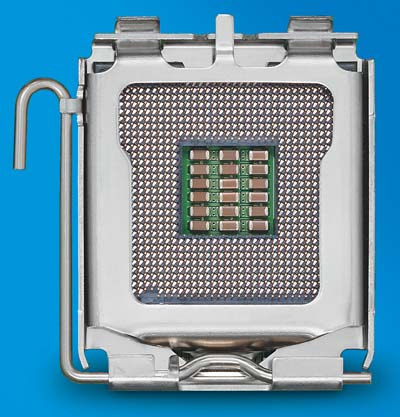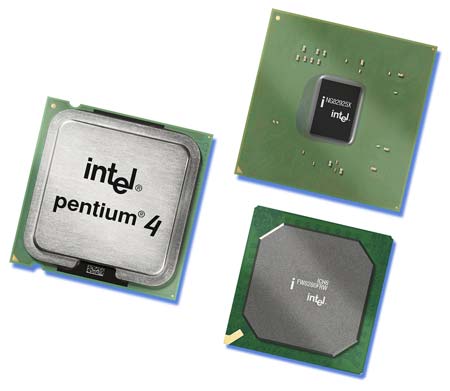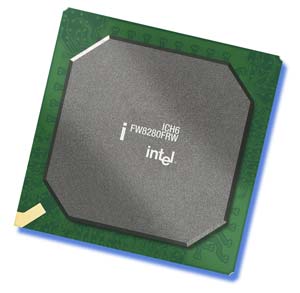Intel 925X/915: Chipset Performance & DDR2
by Wesley Fink on June 19, 2004 3:01 AM EST- Posted in
- CPUs
Intel Socket 775 Chipsets
You're looking at the new 775-pin socket T, which reverses the Socket 478 by putting the pins in the socket on the motherboard. The 775 processor has no pins at all; it has 775 small 'cups' that make contact with the pins in the socket.
The new chipsets for Socket 775 range from the 925X at the top to a full range of mainstream 915 chipsets, both with and without the new Intel Integrated DirectX 9 graphics.

The 915/925X are updates to the current 865/875 chipsets, which will continue in the Intel line for the time being.
All of the new 775 chipsets are paired with the updated ICH6 Southbridge. The ICH6 integrates the new 24-bit 192kHz High-Definition Audio. Intel HD audio also features eight independent DMA audio engines. This can enable multiple separate, simultaneous audio streams.

The new Southbridge also supports four SATA ports, which double the available SATA ports from ICH5. The new SATA ports can support either hard drives or optical devices with hot plug capabilities and Native Command Queuing (NCQ). While the SATA support is still SATA 1 (150MB/s), Intel claims that the new NCQ feature allows faster boots and increases file transfer speeds.
As we first saw on 875/865 family, there is also an ICH6R that can be paired with the new Northbridge chips to provide Intel Matrix RAID capabilities. The new Matrix Raid supports RAID 0, 1, 0+1, and an interesting option that allows combining both mirroring for security and striping for speed using only two drives.
New for 925X/915 is a new "W" Southbridge for ICH6 that supports Intel Wireless Connect Technology. This is designed to simplify wireless networks and connections. The W option is available with the regular Southbridge as ICH6W, and with the Matrix RAID version, ICH6RW. Consider the "W" in ICH6W and ICH6RW a future feature, however, because Intel does not yet have the wireless feature working. The accessory cards for wireless are not available at launch either.
The new Intel chipsets only support one IDE controller, so two IDE devices on the same channel is the only option for IDE. With SATA optical drives only just starting to appear, that means your IDE hard drive and optical IDE device will have to share a single channel. Even if you have SATA drives, your two IDE optical devices will have to share a single IDE channel. It is abundantly clear that Intel is trying to accelerate the move to SATA by limiting IDE options on the new chipsets.










57 Comments
View All Comments
nserra - Tuesday, June 22, 2004 - link
You guys are only evaluating the performance, I think it's not that important, the features yes, those are important. The P4 is crap even with hyper-x,y,z, so it wasn't a "chipset" that was going to make a miracle.I would like to see the new platform tested, IGP, Sound system, EMT64 (is it enable on LGA775 processors?), NX bit?, new power saving techniques, so new features up to test.
At least the DDR vs DDR2 comparison is a good thing.
I was hopping that DD2 would give a performance boast, since the P4 architecture relies on higher bandwidth and higher latency (the pros of RDRAM i850), but I guess not....
Bozo Galora - Monday, June 21, 2004 - link
yes he's sureRyanVM - Monday, June 21, 2004 - link
#54, Are you sure you aren't thinking of the S754/S939 dual socket mobo?tfranzese - Sunday, June 20, 2004 - link
#53, yes, there's a board that was shown at Computex that had both sockets giving the option to use one or the other.RyanVM - Sunday, June 20, 2004 - link
So, any chance that the 915 chipset can be tied to a socket 478 + Northwood? :DMarlin1975 - Sunday, June 20, 2004 - link
AMD does not really need dual ch. memory. Look at the diff. between a socket 939 and 754, it is very little for most apps. Also Dual Ch memory is not new. It was used WAY back in the day.The only reason it is back is because intel can't design a decent CPU so they have to make up for it with pricey and unneeded tech.
tfranzese - Sunday, June 20, 2004 - link
Anemone, there's really little reason you need dual-channel memory on the AMD64 platform with the memory controller being on the chip.Anemone - Sunday, June 20, 2004 - link
Anti overclocking designs in the new chipsets? Very poor choice.I will reiterate Intel performance per $ over its previous generations is pathetic. More $ required per degree of performance and the increase over last year is poor.
AMD is expensive until you get to the 754 - but perhaps I'm mistaken but I thought the industry had left single channel memory configurations behind 2 years ago. Oh wait, it's AMD, that's about their catchup period, sorry. So yes look at AMD in dual channel AMD64 chips and yes they are very pricey. So much for their argument that by providing competition they keep prices down.
Add to all that the overclocking unfriendly stuff, and while AMD comes out as better overall, the performance per $ is still not markedly better than last year, imo.
:)
Bozo Galora - Sunday, June 20, 2004 - link
"My My We are in trouble now arent we..."Yeah, I guess we might have to offer AMD a few of our (cash in the bank) billions to buy them out. I wonder if the FTC will allow that? Hmmmmm. Let's investigate.
firtol88 - Saturday, June 19, 2004 - link
My My we are in trouble now aren't we...Looks like AMD is the clear choice, unless you need a heater.